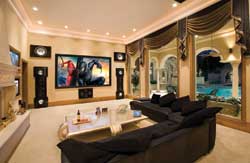

The Commercial-Resi Crossover
In today’s volatile and uncertain market, everyone wants to grow and/or stabilize their business. That includes AV manufacturers, integrators, design consultants, and reps.
In today’s volatile and uncertain market, everyone wants to grow and/or stabilize their business. That includes AV manufacturers, integrators, design consultants, and reps. Many are looking over the fence at what may appear to be greener landscapes. On the surface, it’s logical to consider branching out into adjacent market segments, such as leaping from commercial systems integration to residential, or vice versa. But while there are similarities between the two markets in terms of applications and technologies, there are also critical differences, including how business is conducted.
When it comes to taking on new markets, sadly, there have been more failures and near-misses than success stories. The most common mistake when attempting to move between commercial and residential specialties is to assume the two markets are so similar that all you need to do is announce your intentions and customers will beat a path to your door. It’s not that simple.
Here’s a common scenario: You’re a commercial AV integrator and one of your clients is a dentist with a suite of offices. You’ve installed digital signage for the waiting and treatment rooms and three music zones. The dentist likes your work and asks if you can set her up with a flat-screen TV and multiroom AV at home. You’ve just crossed over. The reverse scenario is similarly easy to envision: The CEO likes what you did for his house, can you do it in his boardroom? Both have been occurring more frequently since the 1980s. And with the way things are, it’s also natural to look for quick wins and easy entry into a new market.
Why does the grass look greener on the other side? Wouldn’t it be better to add new capabilities or product lines and sell them to current customers? It depends. So many companies in the AV industry don’t do the required planning and just leap into the adjacent markets without the knowledge, certifications, and relationships necessary to compete.
Myths and Realities
Here are four common myths about the commercial/residential crossover, which apply no matter which direction your company is moving.
Myth 1: Product is product. If it works in one market, it can work in the other.
Reality: While some AV systems translate better than others, most manufacturers design and manufacture products for either commercial or residential use, differing in reliability, durability, user interface, ergonomics, cosmetics, and ease-of-installation.
Myth 2: Standards are the same in residential and commercial applications.
Reality: Actually, they’re all over the map. While most residential products need to pass UL standards, those same products may not necessarily comply with, for example, fire safety standards. Commercial building codes vary from city to city, and are often different from residential codes. Networked AV systems have different latency and performance requirements in home playback applications than in live event or broadcast applications.
Myth 3: My reputation will get me in the door.
Reality: Yes, your core customers know your reputation for quality, performance, and ease of doing business. But in a new market, you’re up against dozens of entrenched competitors. Customers will ask, “Why should I switch from suppliers I’m already comfortable with?” If you can’t answer that question, you’re not ready to make the crossover.
Myth 4: The sales process and buying cycles are the same in both markets.
Reality: Both are different. So are project life cycles and the basic value propositions. The skills and knowledge required to sell to institutional customers are vastly different from those used on individual residential customers.
Once you’ve acknowledged the differences, you can identify the gaps in your company’s capabilities and spell out what you’ll need to make the crossover (or conclude it’s not in your best interests). Set achievable goals, making sure to spell out success metrics: increased sales and profits, customer acquisition targets, number and size of projects, etc. Create a mini-business plan and profile your current and target customer bases to find parallels you can exploit with your particular skills.
Finally, hire evangelists with relationships and experience in the market you’re targeting. While there are risks inherent in crossing over between commercial and residential AV, they can be managed through planning and market intelligence. There is always room in each market for great companies, but it’s better to do the planning and decide not to enter a new market than to leap before you look.
John Stiernberg is founder and principal consultant of Stiernberg Consulting, serving the entertainment technology, music products, and electronic systems industries. Stiernberg Consulting’s upcoming white paper “Is the Grass Really Greener? Myths and Realities About Crossing Over Residential and Commercial Market Segments in the Electronic Systems Industry,” will be available free to Pro AV readers at stiernberg.com/whitepaper.










